|
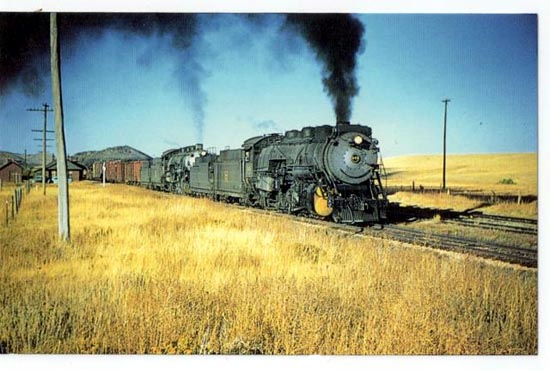
Farthing, Wyoming, 1960's.
South of Chugwater on the old Iron Mountain Road lies the small town of Farthing, one time known
as Iron Mountain. Farthing received its name from Charles T. Farthing (1877-1962) who settled in the
area about 1904 and who donated the land for the
railroad station. Farthing was not, however, the first settler in the area.
Iron Mountain took its name fron a ridge of iron ore of unusual richness. Iron nodules were found by
Capt. Howard Stansury in his expedition of 1850:
The interval until the 6th of Coctober was occupied in making an examination
of the counrtry to the northward of the heads of Lodge-pole; in the course of which we crossed
the several sources of Horse Creek, and entered the picturesque valley of the Chugwater. the
character of the country did not vary materially fron that farther south. In several localities the ground was
strewn with fragments of white quartz, and jasper of a blood-red colour. In the bed of the
Chugwater, and on the sides of the adjacent hills were found immense numbers of rounded black
nodules of magnetic iron-ore, which seemed of unusual richness. the Chugwater winds from side to side
of a level, well-sheltered valley, clothed with abundance of grass, and is handomely timbered with box elder and willow thickets,
affording covert for great nembers of deer, which were more plentiful here than anywhere upon the
route. The valley is a favourite wintering spot for the Cheyenne Indians.
In 1859 and 1866, the presence of the iron also raised the interest of Dr. Hayden.
The mountain is more than a mile in length with the iron-bearing ridge abmout 600 feet in
width. The ore is in a volcanic dike vaying from 40 to 300 feet in width and has assayed at about
50% in purity and, in some samples as much as 80%. In 1870 some ten tons of ore were mined.
Later the Colorado Fuel and Iron Company also mined for a short time. Samples of the ore were
displayed by the State at Chicago's Columbian Exposition. In 1877, Henry T. Williams in his
The Pacific Tourist: Williams' Illustrated Trans-Contintental Guide of Travel predicted that
the purity of the metal would produce development:
About 18 miles north-east from Laramie is Iron Mountain on the head of Chugwater Creek. It is said to be
nearly pure, and will some day be developed. there has been talk of a railroad from Cheyenne with a branch to the mountain.
Although the railroad has been bult, the development has not occurred. Indeed, the hard road northward from Cheyenne ends at Iron Mountain.
Iron Mountain retains fame also as the scene of Tom Horn's most famous murder, that of Willie Nickell.
One of the first settlers in the area of Iron Mountain was Stanton S. "Dick" Latham (1815-1903), a Union veteran who came to Wyoming following the
Civil War. He, at first settled in the area of Fort Laramie Crossing. There, according to William Murphy, an employee of John Iliff, the
Lathams ran one of the first small herds of
cattle in the territory. Others who ran early herds included W. G. Bullock and B. B. Mills. However,
as late as 1870, the entire Territory only had a little over 8,000 head. Later Latham moved to Iron Mountain on the Upper
Chug. There Stanton continued as a small rancher and trapper.
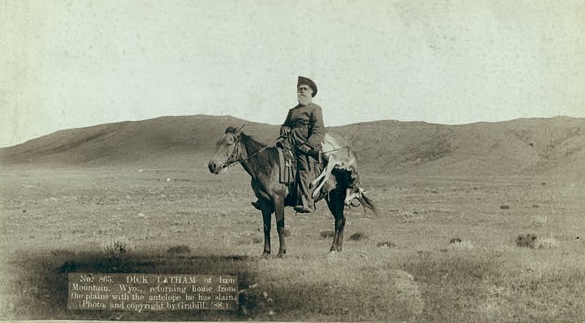
Stanton S. "Dick" Latham of Iron Mountain returning home
with antelope, 1888, photo by John C. H. Grabill.
Stanton Latham had two sons, Gordon and Dan who followed in their father's footsteps and were
small ranchers and trappers.
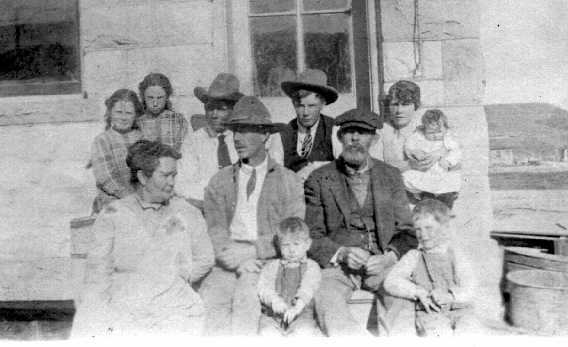
The McDonald Family, Iron Mountain, 1914
In the 1870's an Irish family, the McDonalds, were traveling across Wyoming when the mother died. The
father was presumedly killed by Indians, leaving the three sons, William, Andy and Archie, as
orphans. Archie, was taken in by another family. Gordon Latham on several occasions observed the
William being mistreated. One day, in disgust at William's treatment, he placed William in his wagon and took him home.
He learned from William of the other two brothers. Gordon was able to find Archie and reunited
the two brothers. Unfortunately, the younger brother, Andy, was adopted by
another family passing through Fort Laramie and was, thus, never found.
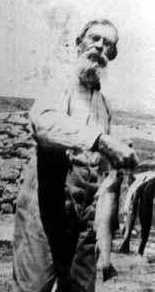 Gordon Latham, undated, photo courtesy Margie McDonald Schrey
Gordon Latham, undated, photo courtesy Margie McDonald Schrey
.
William, himself, homesteaded near Iron Mountain. The
first homestead, as depicted below, was modest, a log cabin with dirt floor. Within ten years, however,
with hard work it was replaced by a more substantial stone house depicted
on the Tom Horn page. When that
house burned in 1912, it was replaced by an even more substantial home, although it was still
necessary to take in borders. But, nevertheless, William was a success, purchasing property in
Cheyenne and becoming a charter member of the Cheyenne Elks Lodge.
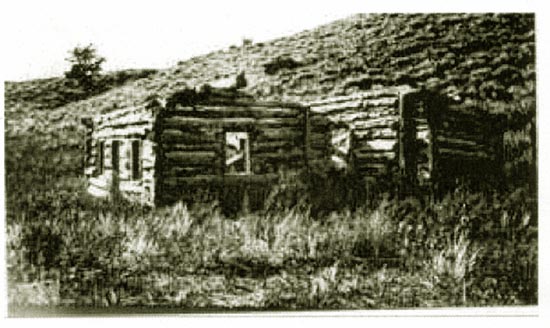
Ruins of McDonald Homestead, photo
courtesy of Margie McDonald Schrey
As an aside, in the late 19th Century and the beginning of the 20th Century, it has
been estimated that some 25 percent of all American men belonged to a fraternal order. Thus,
fraternal orders thrived in Wyoming, with Masonic and other lodges in just about every
town. In some there was a fraternal hall shared by several orders.
Iron Mountain received its name as a result of the early discovery of iron ore in the
area. Surveyor General Silas Reed in 1870 mined 10 tons of ore which was shipped to
St. Louis. Business persons from
both Cheyenne and Laramie took an interest in mining. It, however, never developed, and the
Iron Mountain area remains as a ranching area.
Next page: Homesteading.
|